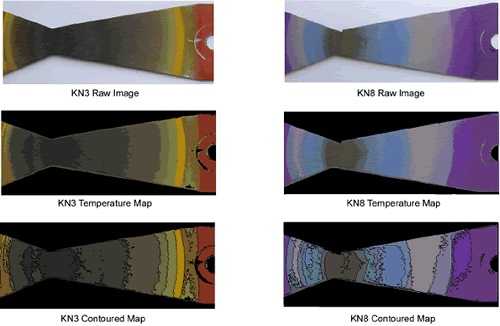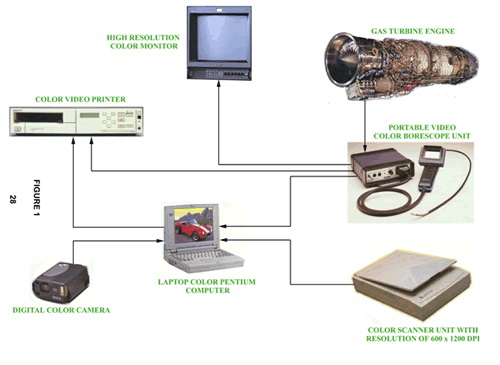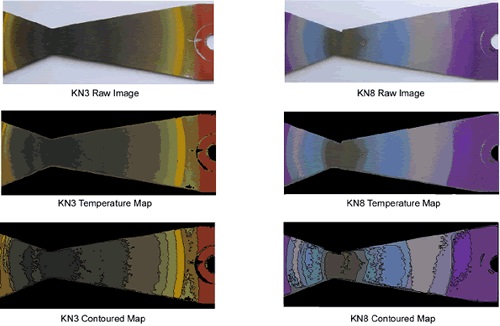
传 真: 021-62315435
邮 编: 200042

|
Thermal
Paint
Introduction
Thermal Paints are coating based products that are temperature sensitive. When
applied correctly, they create irreversible visual pictures of surface
temperature contour patterns. This is an essential tool for the accurate
analysis of high temperature materials working close to their maximum
temperature capabilities.
Thermal Paint Services, Inc. is a technical expert in this field
and has over 30 years of real world test experience with this product. The
company has invested many years of development in paint application
techniques, color contour analysis, incorporation of new technologies to help
in the data gathering and extrapolation and in the presentation and remote
management of test cells and data.
The performance of a gas turbine engine is significantly influenced by turbine
inlet temperature. Higher turbine inlet temperatures give high cycle efficiency
but at the cost of raising the component metal temperature. The allowable
component metal temperatures should not exceed 1700-1900 °F
(927-1038 °C) even for the most advanced alloy to avoid failures. Hence,
accurate measurement of metal temperatures of the components is essential for
component designers so that they can produce reliable and durable
engines.
A heat transfer engineer would have a wealth of useful data if a permanent
record of actual hardware temperatures in an operating gas turbine could be
made. However, measuring actual temperatures of rotating components such as
turbine blades using thermocouples through slip ring tests has been expensive
and difficult at best. In any case, only spot temperatures can be recorded.
Similarly, high frequency pyrometer techniques only give spot temperatures of
components on which a pyrometer probe can be aimed. Temperatures indicating
thermal paints offer a permanent, simple and relatively inexpensive way to
overcome this problem for both stationary and rotating components.
Although thermal paints have been used in turbomachinery design for a long
period of time, the results have often been discouraging due to subjective
interpretation of paint colors, sensitivity to the environment, and inaccuracy
of the predictions. Recent improvements in the application process, gas turbine
test procedure, and color interpretation technique have led to the solution of
these past problems.
Thermal Paint Uses and Advantages
The cost of a thermal paint test compared to a slip ring test is about
30%. By using thermal paints, the test and analysis time can be
reduced by a factor of 3 compared to a conventional test. This combination of
saving cost and test & analysis time reduces the development cost of a gas
turbine manufacturer many folds giving him an edge over competition. The other
obvious cost saving using thermal paints is that the painted parts can be
cleaned and reused after a test, whereas experience has shown that in a
conventional test with thermocouples, many very expensive Pt/Rh thermocouples
need to be attached to parts, and after a single test the parts are discarded.
Also, thermocouples can affect the aerodynamics and thermodynamics of the test
engine which is not the case with thermal paints.
After a test with the painted parts an overall coverage of
isotherms and temperature gradients over the entire surface of a component is
achieved and any local hot spot on a rotating or stationary part can be easily
identified. Any subsequent removal of the local hot spot can be visually
confirmed with thermal paints.
The paint color isotherms can be accurate to ±15ºF (±8 ºC) and
interpolation between isotherms can give an accurate assessment of the
temperature of any point on the component which has been paint tested. The
paints are being used with a high degree of accuracy and reliability in the
design and testing of combustion and turbine components.
The paints can be used on a variety of surfaces, including metallic, ceramic
and plastic, with applications in a range of areas such as:
- Temperature distribution on axial
flow compressor case exteriors, combustion
liners, combustion chamber casings - outer and inner, fuel injectors, glow
plugs, turbine stator vanes - all
stages, turbine rotor blades - all stages, turbine rotor wheels,
turbine vane cases and engine exhaust cones.
- Heat treatment processes
- Composite cure cycles
- Monitoring stored substances
- Monitoring furnace liner conditions
Paint Procedures
Thermal painting involves the applying of a very thin coat of a selected paint
to the required area of a component. Like the liquid crystals, the paint
changes to colors in response to specific temperatures. Unlike liquid crystals,
the reaction is irreversible and the paint retains the color corresponding to
the highest temperature it experienced, making it a permanent record.
The procedure is to paint the parts before an engine is assembled and then
simply install the painted parts into the engine during the test-stand build
up. (Painted parts can be stored in dry conditions for an indefinite period
without any resulting deterioration in performance). After the engine is run
for a predetermined period of time, the painted parts are removed and the
surface color contours remain as a record of the temperatures the surface
experienced.
Interpreting Paint Contours
Skillful interpreting of the thermal paint coloration pattern
after a test run involves four major phases:
A. Isolating with boundary lines the various color zones on
the painted parts.
B. Assigning quantitative values to each isotherm area.
C. Recording the paint pattern, by photographic means.
D. Analysis by the engine designer.
The boundary lines of the paint color contours are sketched by
hand by skilled personnel. Alternatively, color digital photographs can be
taken and an image manipulating software can be utilized to process color
images of paint color contours.
Quantitative values are assigned to each isotherm area by the use
of calibrated test coupons. This is the key to the temperature/color
relationship.
Any single color in the series can span a 100-200 ºF (38-93ºC) temperature
range. So, assigning an exact quantity of temperature may seem a problem, but
an exact temperature can be assigned to any transition point between the
sequential colors. Also by using different paints with different color bands
(i.e. different temperature bands) for the same target surface temperature, it
is possible to narrow down an area's temperature to ±30 ˚F (±17ºC). For example: turbine rotor
blades which experience the same test temperature due to rotation can be
painted with different paints in order to narrow down the temperature
represented by the color bands.
The color change depends mainly on the operating temperature, but exposure time
to operating temperature also influence the color change. So the parts have to
be tested for selected times.
Analysis of the contoured parts by an engine designer often leads to
elimination of problem areas or to specific improvements in a previously
satisfactory component. Also several configurations of the same component (for
example different cooling schemes of a cooled turbine rotor blades) can be
paint tested in a single rainbow test to determine the resultant variations in
temperature due to different cooling schemes or the best feature of a
particular scheme. Cooling effectiveness can be calculated and the turbine
rotor entry temperature profile coming from a combustor can also be determined.
TPS Thermal Paints
Multi-Change Paints
|
Paint Name |
Temperature range |
|
|
oF |
oC |
|
|
KN1 |
320-446 |
160-230 |
|
KN2 |
468-491 |
242-255 |
|
KN3 |
914-2282 |
490-1250 |
|
KN4 |
219-405 |
104-207 |
|
KN5 |
307-1922 |
153-1050 |
|
KN6 |
302-2139 |
150-1170 |
|
KN7 |
662-1517 |
350-825 |
|
KN8 |
419-1670 |
215-910 |
|
KN9 |
215-910 |
232-262 |
|
KN10 |
752-1042 |
400-561 |
|
KN11 |
275-401 |
135-205 |
|
KN12 |
329-473 |
165-245 |
|
KN13 |
968-2021 |
520-1105 |
|
KN14 |
743-1076 |
395-580 |
|
KN15 |
531-2255 |
277-1235 |
|
Paint Name |
Color Change Temperature |
Initial Paint Color |
Final Color |
|
|
oF |
oC |
|||
|
CJKN1 |
118 |
48 |
Pink |
Lavender Blue |
|
CJKN2 |
176 |
80 |
Pink |
Lavender |
|
CJKN3 |
311 |
155 |
Blue |
Dark Green |
|
CJKN4* |
367 |
186 |
Yellow |
Black |
|
CJKN5* |
437 |
225 |
Yellow |
Black/Brown |
|
CJKN6 |
464 |
240 |
Yellow |
Red/Brown |
|
CJKN7 |
527 |
275 |
Blue/Grey |
Lavender |
|
CJKN8 |
693 |
367 |
Mauve/Red |
Grey |
|
CJKN9 |
752 |
400 |
Mauve |
White |
|
CJKN10 |
837 |
447 |
Green |
Salmon Pink |
|
CJKN11 |
856 |
458 |
Green |
White |
|
CJKN12 |
1022 |
550 |
Orange |
Yellow |
|
CJKN13 |
1166 |
630 |
Red |
White |
|
(* = Water based paints not suitable for spraying, should be brush applied) |
||||
Thermal Paint Color Analysis Digital System (TPCADS)
The Thermal Paint Color Analysis Digital System (TPCADS) consists
of the following parts:
Hardware:
- Lumenera USB professional digital camera
- Lens and lens adapter
- Cameral adjustable rail
- Linear LED lights, with four 36w fluorescent tubes
- Kaiser Stand RSX with Arm RTX, base 20” x 24”
- Computer System with 19" monitor
- Another VGA display
- VGA splitter
- VGA extension cable
Software
Customized software for image acquisition and color
classification, incorporating the proprietary knowledge of thermal paint
pattern recognition and paint contours interpretation as well as many years of
experiences, following perfectly the procedure for thermal paint coloration
pattern interpretation procedure. Customers could store the color chip /
temperature data into the system for later color calibration, or make use
of the 3D color scheme, or even directly extract color from images as basis for
color recognition. Images will be processed automatically by the software in
order to output isotherms and temperature distributions. The software features
a higher capability of color recognition with more accuracy, and an absence of
human subjectivity of recognizing different colors, producing consistent color
results that can be repeated time and time again. Besides, all the results are
digitally stored, providing excellent support for interpreting personnel and
engine designers.
Schematics of TPCADS system, components and peripheral devices

Examples of the color analysis software
